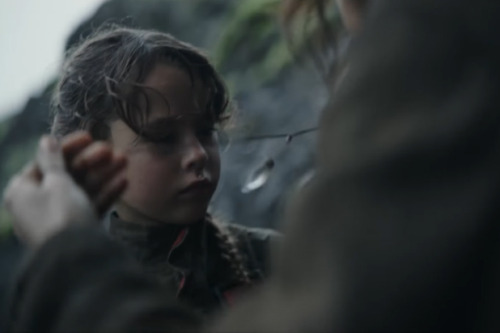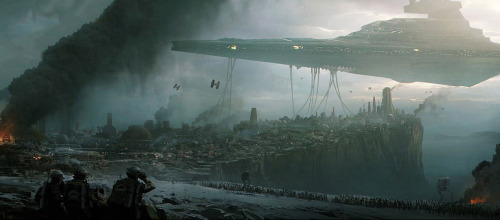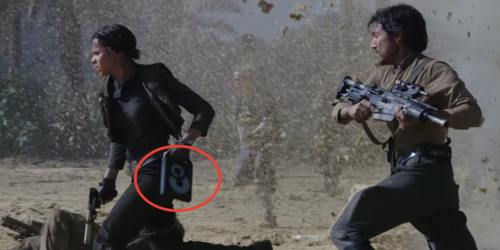
Take a drink if you’ve heard this one before, but for me, one of the things which set Rogue One apart from the previous Star Wars films was its archaeological sensibility.
While The Force Awakens had plenty of ruins, and featured one iconic artefact from the original trilogy, there was no real sense that history extended beyond the events of Episodes IV-VI. Yet with Rogue One, turn any stone and you’ll see the remnants of a past so deep that even its creators have only glimpsed it. The film also draws from the prehistory of George Lucas’ own writing, going back to his early journals from 1973. As if you needed another excuse to re-watch Rogue One, here is a handy guide to the archaeological items and motifs you may have missed. And do I really need to warn about spoilers? I’m surprised I haven’t spoiled anything already. Valar morghulis.
Jyn Erso’s kyber crystal pendant

It’s no lightsaber, but it’ll have to do (source)
The first proper artefact we see in the film is a kyber crystal pendant given to the young Jyn Erso by her mother Lyra. There is no indication of how Lyra came into possession of one, or how long it has been a family heirloom; adding to its mystery, it is apparently inscribed in Aurabesh.
To get answers, I had to turn to the awkwardly titled Star Wars: Rogue One: The Ultimate Visual Guide (UVG) by Pablo Hidalgo, Lucasfilm’s story czar. Published for kids and incurable nerds, this volume provides canonical explanations for the tiniest details of costume, prop and set design for the film. Here we are given Lyra’s fascinating backstory, revealing she met her future husband Galen Erso while surveying cave systems on distant planets researching kyber crystals. She is also a keen student of Jedi theology, and the red sash she wears is apparently a token of her devotion to the Force. In fact, in an early version of the script, she was a Jedi herself. The crystal she wore around her neck came from Galen’s research collection. It is not clear whether it was at this point already inscribed.

Beats a rabbit’s foot, thought young Jyn (source)
Nerds are already well aware that kyber crystals are the mysterious semi-divine materials which power Jedi lightsabers, and as the film makes clear, also power the Death Star’s superlaser. They are very much the Star Wars saga’s Rings of Power, in that they are also animate objects, receptive to the will of the Force and exerting effects on the Force-sensitive. Partially organic, they vibrate and emit harmonics, allowing someone like Chirrut Îmwe with super-hearing to use them to his advantage. This is how he is able to perceive Jyn’s kyber pendant in the busy marketplace on Jedha, and it turns out Chirrut also has a sliver of kyber of his own in the metal end of this staff.
Kyber crystals thus form a clever material metaphor for the Jedi; worn or carried by two of the main characters, they are present throughout the film but only rarely glimpsed, like medieval saint’s relics. Rogue One is famously the first Star Wars film to not revolve around Jedi or Sith characters, but the Force is strong in this episode. The Jedi are not physically present, but from Lyra Erso to Chirrut, the film is full of people who are in awe of the Force, or bent on using its secrets to control the galaxy. The saga is quickly becoming less a hero’s journey and more a hagiography of canonised Jedi saints.
Yavin 4’s Great Temple

The not-quite-Mayan pyramids of Rogue One (source)
The appearance of the Rebel Alliance headquarters on Yavin 4 is pure nerd catnip, taking us into the pyramids glimpsed so briefly from a distance in A New Hope. It’s not just the Empire ransacking ancient monuments during this Galactic Civil War: the Rebel Alliance ensconced themselves in abandoned pyramids on a distant forest planet. They appear to have gutted out the ground levels of these monuments for use as hangars for their space fleet. Further research reveals these are the 5000 year-old temples of the Massassi, an extinct people with a tragic history. We don’t know much more about them, not that it matters much in the long term as they were evacuated immediately after the Battle of Yavin which follows soon after the events of Rogue One. Interestingly, Yavin 4 was not completely abandoned, as a small colony was set up there after the Battle of Endor, and this happens to be where our new favourite flyboy Poe Dameron was born. Given the impact of the events and historical figures that passed through here, I hope the Galactic equivalent of UNESCO doesn’t try to undo the modifications on these temples wrought by the Rebels, as it is a crucial part of the long-term importance of this site.

The actual Mayan pyramids of A New Hope (source)
Oh, and these pyramids are of course inspired by the real-world Mayan pyramids of Tikal in modern-day Guatemala, where George Lucas sent a crew to film for a few landscape views back in 1977. Interior shots were all studio creations, and Rogue One’s temples show some artistic license taken by the designers this time around to make them a bit Star Warsier more than Mayan, but in wide shots they are unmistakeable Earthling archaeology.
Jedha and the Whills

We’re gonna need a longer extension cord (source)
The centrality of the Force to this film is shown in the centrality of Jedha. Jedha is one of the galaxy’s main sources of naturally-occurring kyber crystals. It is also the main pilgrimage destination of worshippers of the Force, as it claims to be the site of the first Jedi temple. According to the UVG, the deserts are also dotted with ancient ruins and remnants of some of the oldest civilisations in the galaxy. The parallels with modern-day Mecca and Jerusalem are intentional, according to another nerdy companion volume, The Art of Rogue One: A Star Wars Story: “To better imbue the setting with a sense of scale and significance, artists found inspiration in human history”. As designer Doug Chiang puts it, “[we] don’t treat these movies like science fiction, but more like historical films.”
We see Jedha as a city under occupation, an Imperial Star Destroyer parked menacingly above, Imperial tanks patrolling the streets, and the attendant violence from rebel insurgents. The sacred places, including the central Temple of the Whills, have been looted for their precious kyber, which is now destined to fuel the Galaxy’s deadliest weapon. This would be like stealing the Black Stone of Mecca to power a nuclear warhead.
The involvement of Chirrut Îmwe and Baze Malbus is a direct result of the Empire’s meddling in Jedha. They were both formerly Guardians of the Whills, an order of warrior monks tasked with protecting the Temple, but now find themselves out of a job as the temple was decommissioned. These events may also have galvanized the defection of Imperial pilot Bodhi Rook, a native of Jedha. It seems in hindsight that the desecration of this holy place was a fatal overreach for the Empire.

Sometimes there is such a thing as too much statue (source)
Another way of looking at it is that the near-extermination of the Jedi 19 years previously had already resulted in a demotion of the Jedi from a core pillar of the Galactic Republic to an underground cult. Pillaging the Temple of the Whills would not have been seen as a desecration but a consolidation of Imperial rule. This turning away from cultural heritage is embodied by the fallen Jedi statue seen being slowly engulfed by the sands of Jedha. What other galactic heritage had been lost in the rise of the Empire? Along with the first Jedi Temple (or oldest surviving after Jedha?) glimpsed at the end of The Force Awakens, the addition of Jedha to the Star Wars universe shows that our generation’s post-Lucas saga is more interested in exploring the roots of the religion of the Jedi than their heroic exploits.
So what on earth is a Whill? If the ancient Temple and fallen statue are links to deep prehistory within the Star Wars universe, the Whills are Rogue One’s way of reaching into the prehistory of Star Wars itself. George Lucas’ first draft of what would eventually become Star Wars was a couple of pages of notes scribbled down in 1973 under the heading ‘Journal of the Whills’. It seems the original idea was for the stories of the Jedi to have reached us through a sort of intergalactic Red Book of Westmarch, but this was eventually abandoned. Lucas intended for the Whills to remain in the universe as a secretive cult of the Force, but the word has never been spoken on screen until now. It cements Rogue One not as an outlier to the original trilogy, but a sort of exegetical commentary on a text that has since become sacred.
Saw Gerrera’s Hideout

Sometimes there is such a thing as too much bass (source)
Just down the road from the Holy City of Jedha is a natural steeple of rock rising up from the desert which houses the secret headquarters of the extremist rebel Saw Gerrera. We only get a few glimpses of the structure but it appears to be a pretty ostentatious hiding place, in a towering Petra-like rock-cut temple approached by an avenue of space-trilithons. The UVG reveals that this is an ancient tomb called the Catacombs of Cadera, which was formerly used as an ossuary for a convenient ‘people whose name and history have been long forgotten.’ It seems it is not only the Empire who are busy pillaging Jedha’s heritage resource in times of war.
Further research reveals there are yet more artefacts hidden in the Catacombs, although I’m not sure how visible these are in the final cut of the film. The hideout apparently includes cave paintings, perhaps inspired by the petroglyphs found in Wadi Rum, Jordan where the Jedha landscapes were filmed. However, these are not the art of some lost people, but creatures from Rogue One director Gareth Edwards’ previous films, including the 2014 Godzilla.
Darth Vader’s castle on Mustafar

The realtor did tell me this area was so hot right now (source)
You may have noticed the way that, unlike previous Star Wars films, Rogue One uses title cards to name the various planets as we go along. One location that is not named is the lava planet with a massive castle straddling a river of magma, which turns out to be Darth Vader’s residence on Mustafar. This is (pushes glasses up bridge of nose), of course, the planet where Obi-Wan Kenobi nearly killed his former padawan Anakin Skywalker (now renamed Darth Vader) leaving him for dead after a vicious duel as depicted in Episode III: Revenge of the Sith. After Vader was stitched up and made into the sci-fi Nazi samurai we all for some reason love, he apparently couldn’t get enough of the place and set up shop there in a big obsidian tower straight outta Mordor.
So it’s a clear link to the much maligned prequel trilogy, but wait, there’s archaeology here too! According to the Art of Rogue One, ‘The stark, modern structure is built over an ancient castle full of dark secrets’, or as explained by production designer Doug Chiang, ‘we don’t see it all right now, but the idea was that Vader’s castle was built over a natural cave — a Sith cave deep down below, in the lava world.’
What is it about bad guys occupying archaeological monuments as their lairs? There’s more than just a passing resemblance to Sauron’s preferred mode of pointy black architecture. You may remember my excavation of The Hobbit films on this blog, where I discussed the foundation of the Necromancer’s Dol Guldur on the ruins of an ancient Elven hall deep in Mirkwood. The explanation of the shape of the castle according to the designers is also distinctly Tolkienesque, or specifically Two Towers-esque. Its ‘tuning fork’ shape helps harness the Dark Side of the Force, and echoes the design of the Temple of the Whills on Jedha which apparently uses the same principle to channel the Force. Vader, like Saruman, is nothing if not a scholar of ancient myth and theology.
Red and Gold Leader

…and then she said, Yavin? I barely even know him! (source)
Rogue One will also be remembered as the first big production to digitally dig up the dead and make them do our bidding on the big screen. While Grand Moff Tarkin and Princess Leia are digitally reconstructed to horrific effect, two other characters were welcomed back to the big screen in an altogether more fitting fashion. These are the Rebel pilots who go by the callsigns Red and Gold Leader, played respectively by Drewe Henley (who, like Carrie Fisher, died in 2016) and Angus Macinnes. They were spliced into their cockpits from forgotten unused footage from 1977’s A New Hope ‘excavated’ by director Gareth Edwards from the Lucasfilm archive on Skywalker Ranch. These clips are therefore the only physical artefacts from the original trilogy that appear in Rogue One. It is a reminder of how a movie, or any piece of intangible culture, is just the public-facing side of a much larger material assemblage including, props, sets, and yes, the physical media itself. Which leads us to my favourite bit of media archaeology in Rogue One:
The Death Star data tapes

I promise I’ll remember to rewind next time! (source)
Described in A New Hope as ‘data tapes’, the Death Star plans which are the MacGuffin of our film confusingly appeared in 1977 only as a flat datacard. Rogue One (finally!) shows us how the data was transferred to this datacard from the original tapes, which sounds like a joke but forms the basis for the film’s climactic battle sequence. The tape is stored in a ludicrous Imperial cassette tower on Scarif. It needs to be physically removed from the tower and manually inserted into a tape reader set precipitously at the top of the spire, to be broadcast from an antenna and dish array. This is thrilling action only for aging computer geeks, who are, of course, the target audience here.
There is a surprising amount of online literature breaking down the various media formats used in the Star Wars films, including this scathing report on the flaws in the Empire’s digital preservation policies as revealed in Rogue One. But this long-read from Jalopnik has got to be the best: “Are there any words that get people more excited than large-scale, long-term data storage? I fucking doubt it.” They explain why the Empire holds on to seemingly antiquated analog media like magnetic tape, which essentially comes down to rigorously maintaining galaxy-wide data compatibility standards. It is not necessarily science-fiction, either, as the US Army still runs its nuclear arsenal on cyberattack-proof floppy disk-based software, and for long-term storage of data, it is still hard to beat tape.

Rogue One: Search for the Missing Adapter (source)
Believe it or not, there are lessons for archaeologists here, in that it forces us to re-examine our oddly unquestioned attachment to planned obsolescence, and the archiving issues that it is already causing us. In a time when magnetic media are slowly being killed off, tapes and physical media like vinyl continue to come back in fashion. The satisfying clunk of loading a heavy cartridge like the Death Star plans into a tape deck and the whirr of the reels as the data comes to life are small pleasures lost to us today which can only be experienced vicariously in sci-fi fantasy such as this. Recreating 1970s artefacts such as these are a way of exploring past futures and questioning the present, the mission not just of media and contemporary archaeology, but arguably archaeology as a whole.
Conclusion
This deep dive into the archaeological record of the Star Wars universe as depicted in Rogue One reveals that the Galactic Civil War had one pernicious side effect: fighters on both sides neglected their cultural heritage in the name of military expediency. Of all the dark goings-on under the Empire, this is one of the most upsetting in the long term. In just a single generation, the shining temples and cities of the prequel trilogy have given way to the ruinscapes of Rogue One, a situation that has not much improved by the time of Force Awakens. And as that film shows, the old Imperial ideology survives like a weed, sprouting back up in the fertile soil of a pastless society.
It also shows that we can assess pop culture as archaeology, through the way in which the material culture of previous films is reused, reconstructed, cited and remixed by later generations. The fastidious attention to continuity taken by the designers as revealed by the Ultimate Visual Guide and Art of Rogue One companion volumes shows that authenticity is expressed through fidelity to tangible objects, sets and settings. There are plenty of lessons in here for archaeologists trying to understand the public appetite for heritage and a sense of connection to a deeper past.
And this may well be why Rogue One is so much more archaeological than the previous Star Wars films. Like The Hobbit trilogy before it, it is simultaneously trying to construct an ancient fictional past, call up memories of films which take place in its future, and provide exegetical commentary on the now-sacred original text in our timeline. Grafting entirely new characters and landscapes and onto a literally canonised set of scriptures can be perilous. In order to justify these inauthentic appendages, it grounds the story in the perceived authenticity of material culture. These new artefacts are retconned into the original narrative in order to create a more ‘realistic’ universe, similar to what Tom Shippey famously called the ‘asterisk history’ of Tolkien’s legendarium. It shows our generation’s need to plug the gaps and make legit mythology out of what others see as fairy-stories. It is nothing less than the archaeology in, of and through popular culture, and I am quite clearly obsessed.
Follow us on @AlmostArch
Notes
colonelcaroldanvers liked this
puckbees liked this
 tinyshippingtrash liked this
tinyshippingtrash liked this silverstarling21 liked this
faeymouse liked this
 shadowaccio6181 liked this
shadowaccio6181 liked this aquastranger reblogged this from blackkatmagic
aquastranger liked this
 hiramsbottle liked this
hiramsbottle liked this gasolinecandy reblogged this from blackkatmagic
 evilbrat2013 liked this
evilbrat2013 liked this  lordgrimoire liked this
lordgrimoire liked this anotherbrother reblogged this from nientedal
soulsinsolarem liked this
wearsshoes reblogged this from lullabyknell
 girlysword liked this
girlysword liked this astaraeldarkrahblack liked this
 lukeskystroller liked this
lukeskystroller liked this clousi liked this
 queercaptainflint liked this
queercaptainflint liked this  profondo-blu liked this
profondo-blu liked this dimondlite reblogged this from lullabyknell
dimondlite liked this
 ocacsclpe1-blog liked this
ocacsclpe1-blog liked this themouseavenger liked this
 bunnybunbunny reblogged this from anakinpls
bunnybunbunny reblogged this from anakinpls wai-nan liked this
im-funny-fight-me liked this
whaturlisntinuse liked this
endeni reblogged this from thriceandonce
endeni liked this
irregulation liked this
 manythingsarewrong reblogged this from lullabyknell
manythingsarewrong reblogged this from lullabyknell  manythingsarewrong liked this
manythingsarewrong liked this nientedal liked this
thebestflowergirl liked this
queeninthenorthwest liked this
skybelt reblogged this from astarsdarkheart
re-white liked this
myo-da-soocha liked this
 fangirlshrewt97 reblogged this from kayliemalinza
fangirlshrewt97 reblogged this from kayliemalinza rubyapologism liked this
ahumanshapedspace liked this
almostarchaeology posted this
- Show more notes
